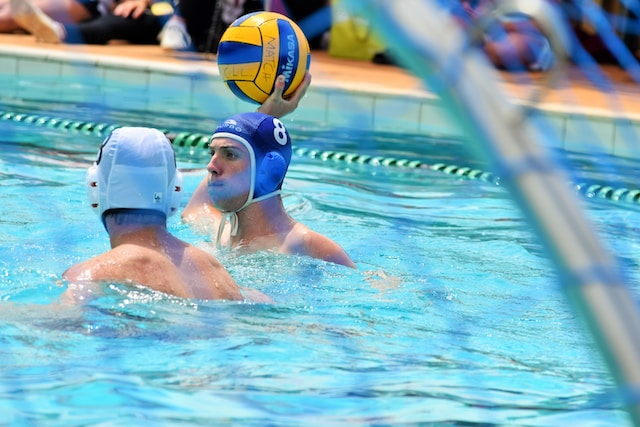A water polo game is a thrilling and intense sport that requires speed, strength, and endurance. It is a team sport that is played in a pool, and it involves players swimming, passing, and shooting the ball into the opposing team’s goal. One of the most common questions that people ask about water polo is how long the game lasts.
A typical water polo match is usually split into four quarters, and each quarter has a duration of eight minutes. Due to the clock being paused when the ball is not in play, the average length of a quarter is approximately 12 minutes.
Teams have a time limit of 30 seconds to hold onto the ball before attempting to score a goal. Additionally, there are two-minute intervals between each quarter, and a 10-minute halftime break between the second and third quarters. Typically, younger age groups play quarters that last between 5 to 6 minutes.
Water Polo Game Duration
Water polo is a fast-paced, physically demanding sport that requires endurance, strength, and skill. The duration of a water polo game is an important factor to consider when preparing for a match. In this section, we will discuss the regulation game length and overtime rules in water polo.
Regulation Game Length
A regulation water polo game consists of four quarters, each lasting eight minutes, for a total of 32 minutes of gameplay. The clock runs continuously throughout the game, except in certain situations, such as when the ball goes out of bounds or a foul is committed.
Furthermore, there are two-minute intermissions between the first and second quarters, as well as the third and fourth quarters. Additionally, there is a 10-minute break between the second and third quarters.
It’s important to note that the length of a water polo game may vary depending on the level of play.
For example, at the collegiate level, there may be two straight three-minute periods, If the match is still tied, subsequent to the regular time, the game continues with multiple three-minute golden goal overtime periods.
Overtime
If the game is tied at the end of regulation play, overtime rules come into effect. In international water polo, there is no overtime period, and the game proceeds to a shootout to determine the winner. In collegiate water polo, there may be multiple three-minute golden goal overtime periods until a winner is determined.
It’s important for players and coaches to be aware of the overtime rules and how they differ at different levels of play. Understanding the game duration and overtime rules can help teams prepare and strategize effectively for a water polo match.
Game Breakdown
Water polo is a fast-paced and exciting sport that requires skill, strategy, and endurance. Understanding the breakdown of a game is crucial for players, coaches, and fans alike.
Quarters and Halftime Break
A water polo match is split into four quarters, with each quarter having a duration of eight minutes. The clock runs continuously throughout the game, except in certain situations such as when the ball goes out of play. After the second quarter, there is a halftime break of five minutes.
During this time, teams can regroup, make adjustments, and rest before returning to the pool for the second half of the game.
Timeouts
Each team is allowed two timeouts per game, which can be used at any time during the game. A timeout lasts for one minute, during which the coach can talk to the team, make substitutions, and provide guidance.
Additionally, a timeout is automatically called when there is an injury or an exclusion foul is given. In these cases, the injured or excluded player must leave the pool, and the team can use the timeout to make adjustments and substitutions.
Overall, a water polo game is an intense and exciting experience that requires endurance, skill, and strategy. Understanding the breakdown of the game, including quarters, halftime, and timeouts, is essential for players, coaches, and fans to fully appreciate the sport.
Factors Affecting Game Length
Fouls and Exclusions
Water polo is a physical game, and fouls and exclusions can slow down the pace of play. A foul is called when a player interferes with an opponent’s ability to move or play the ball, and can result in a free throw for the opposing team.
An exclusion is a penalty in which a player is removed from the game for 20 seconds, leaving their team with one less player in the water. These stoppages can add time to the game, especially if they occur frequently.
Ball in Play
The clock in water polo runs continuously, except in a few different situations. For example, the clock is stopped when a ball goes out of play or when a foul or exclusion is called.
This means that the more time the ball is in play, the longer the game will be. Teams that are able to maintain possession of the ball and keep it moving can control the pace of the game and potentially shorten its length.
Other Factors
Other factors that can affect the length of a water polo game include the level of play, the number of timeouts allowed, and the number of goals scored. Higher levels of play may have longer game times, and timeouts can add extra stoppages to the game.
Additionally, if a game is close and both teams are scoring frequently, the game could potentially go into overtime, further lengthening its duration. Overall, the length of a water polo game can vary depending on a number of factors.
While the standard game length is four quarters of eight minutes each, the actual time of gameplay can be affected by fouls, exclusions, and the amount of time the ball is in play.







